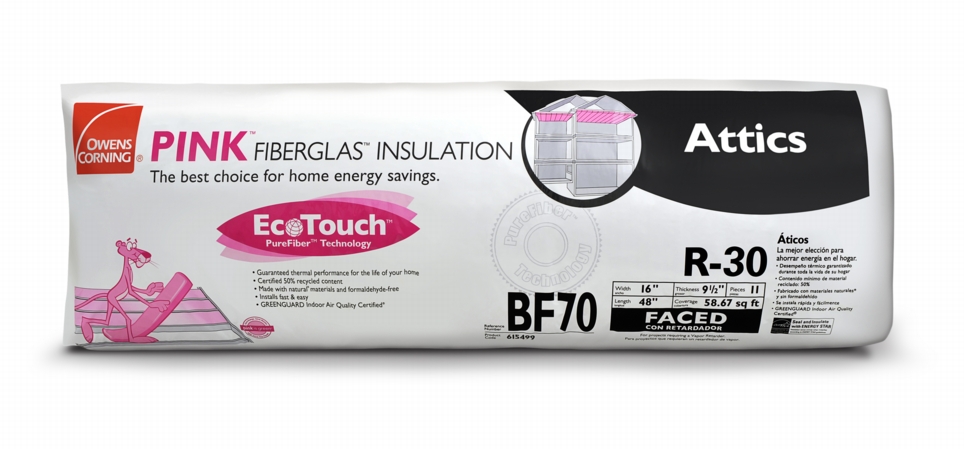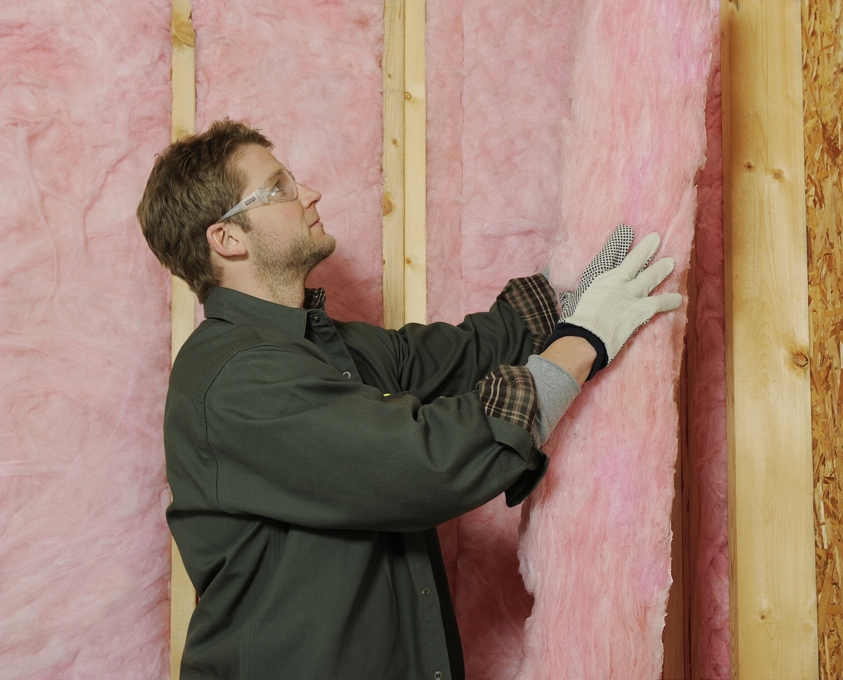Blog Post
Greening the Pink Panther: Owens Corning's New EcoTouch Fiberglas

Owens Corning, whose pink fiberglass insulation has been around for more than 70 years, whose shade of pink is trademarked, and whose Pink Panther has become almost synonymous with insulation, has begun a top-to-bottom transformation of its fiberglass insulation. Beginning next month, EcoTouch? Fiberglas? insulation with PureFiber? Technology will begin replacing the company's traditional fiberglass insulation, which is produced with phenol formaldehyde binder.
While Owens Corning would not divulge the exact make-up of the PureFiber binder, it is described as formaldehyde-free and "made from widely available plant materials." Owens Corning joins two other fiberglass insulation manufacturers that offer non-formaldehyde plant-based binders: Knauf, which introduced its EcoBatt made with Ecose Technology in late 2008, and CertainTeed, which introduced its "Sustainable Insulation" in mid-2010. None of these manufacturers have made public exactly what their binders are, though all claim that the binder is plant-based. The other major fiberglass insulation manufacturer, Johns Manville, switched from phenol formaldehyde binder to a non-formaldehyde acrylic binder in 2001--thus leading the shift away from formaldehyde.
The transition to EcoTouch with PureFiber Technology will take several years. I was told by the company that EcoTouch is "being incorporated as a rolling change into all Owens Corning's existing PINK FIBERGLAS Insulation beginning in March 2011. It will start to become available in retail locations throughout the United States in April 2011, and is expected to be available for some commercial and industrial products beginning May 2011. The full suite of product offerings will be rolled out over the following 18 to 24 months.
Along with the new binder, Owens Corning has increased the recycled content of its fiberglass insulation: to a minimum of 30% post-consumer and 50% total recycled content, as certified by Scientific Certification Systems, a third-party certifier of environmental claims.

What about the pink dye?
SUPPORT INDEPENDENT SUSTAINABILITY REPORTING
BuildingGreen relies on our premium members, not on advertisers. Help make our work possible.
See membership options »It stays. "The color pink is a brand icon and important to our customers as an aspect of the Owens Corning fiberglass insulation product," I was told by the company. "In reformulating the binder, we also had to look for an appropriate dye that was compatible with the new formulation. The compound used to produce the soft pink color is used in very small amounts--less than one-tenth of one percent of our product, and poses no safety risk to our customers or adverse environment impact."
Nonetheless, the company is also looking to green the dye, which is described as a synthetic material today. Owens Corning is "active in looking for a plant-based or other renewable material base that could be used instead," according to the company. "So far, we have not found another material that meets the performance, compatibility and material safety aspects required for substitution," I was told.
Performance and price
While the EcoTouch Fiberglas is not yet out there in commercial use (so I was not able to talk with users), Owens Corning ran trials of the product with 90 professional insulation contractors during 2010, according to the company. These trials were conducted in Toronto, Ontario, and Edmonton, Alberta, by Drucker Worldwide, and two-thirds of the professional installers preferred EcoTouch over competing fiberglass insulation products (both standard Owens Corning and competing fiberglass products were used in this study) for its speed of installation, ease of cutting, product recovery, stiffness, strength and softness. It is also described as producing "less dust than other fiberglass insulation products."
While pricing of Owens Corning Fiberglas is up to distributors and dealers, the introduction of EcoTouch should not change pricing structure, according to the company.
Why the change?
Chuck Dana, the group president for building materials at Owens Corning, put it this way in response to my query: "More than ever it is important that homes are built with sustainable products and building practices, minimizing our impact on the natural environment." The introduction of EcoTouch "reflects our relentless pursuit of the most environmentally sustainable and efficient ways to insulate homes and buildings," he said.
For more information:
Owens Corning
Toledo, Ohio
800-438-7465
Alex Wilson is the executive editor of Environmental Building News (now in its 20th year) and founder of BuildingGreen, Inc. In addition to this product-of-the week blog, he writes the weekly Energy Solutions blog. To keep up with his latest articles and musings, you can sign up for his Twitter feeds. Products covered in his product-of-the-week column are--or soon will be--listed in BuildingGreen's GreenSpec Directory.
Published February 2, 2011 Permalink Citation
(2011, February 2). Greening the Pink Panther: Owens Corning's New EcoTouch Fiberglas. Retrieved from https://www.buildinggreen.com/blog/greening-pink-panther-owens-cornings-new-ecotouch-fiberglas



Add new comment
To post a comment, you need to register for a BuildingGreen Basic membership (free) or login to your existing profile.